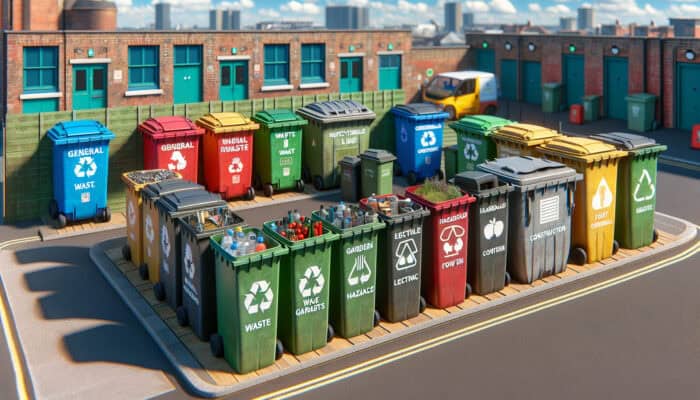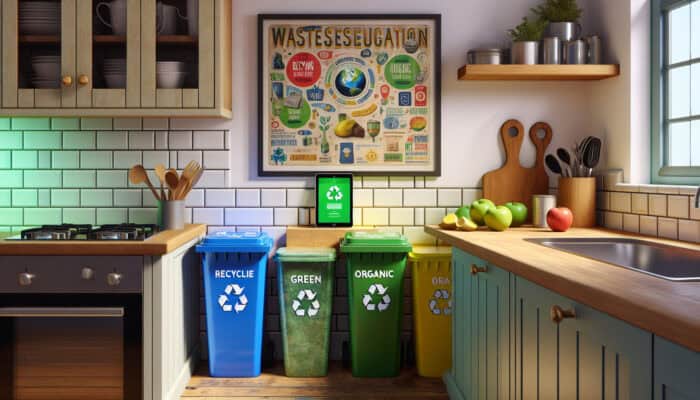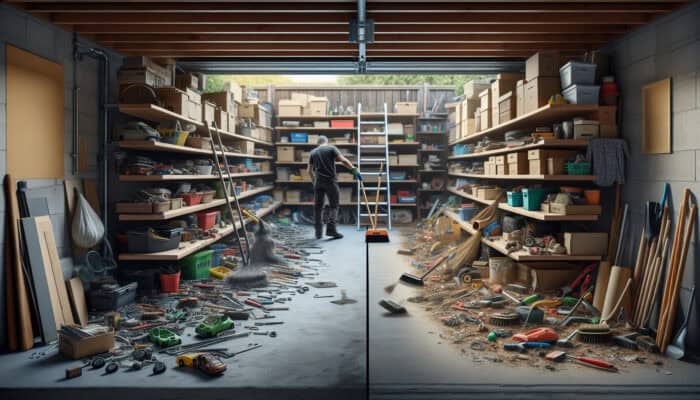Introduction to Waste Segregation in the UK
What is Waste Segregation?

Waste Segregation Tips for House Clearance: Waste segregation refers to the process of categorising waste into designated categories to facilitate its proper recycling and disposal. This method plays a pivotal role in enhancing environmental sustainability and streamlining waste management systems in the UK. The following are key categories of waste that should be segregated:
- General waste
- Recyclables (paper, plastics, metals, glass)
- Garden waste
- Hazardous waste (batteries, chemicals)
- Electronic waste
- Construction and demolition waste
- Food waste
Effective waste segregation ensures that materials are processed correctly, minimising contamination and maximising recovery rates while fostering a cleaner environment.
Why is Waste Segregation Important in the UK?
Segregating waste is crucial for reducing the amount of refuse sent to landfills, promoting recycling initiatives, and ensuring compliance with environmental regulations. Understanding the importance of this practice can significantly motivate households to adopt more sustainable habits. The benefits of waste segregation are manifold:
- Reduction in landfill usage
- Increased recycling rates
- Lower greenhouse gas emissions
- Conservation of natural resources
- Enhanced community responsibility and environmental awareness
The more effectively households engage in waste segregation, the greater the overall positive impacts on the environment and society.
Legal Requirements for Waste Segregation in the UK?
The UK has established a framework of laws and regulations related to waste management that includes mandates for waste segregation. Being aware of these legal stipulations is essential for households to avoid potential penalties. Key legal requirements include:
- Compliance with local council waste disposal regulations
- Correct categorisation of hazardous waste
- Adhering to the Waste (England and Wales) Regulations
- Ensuring the correct separation of recyclable materials
- Participation in local recycling schemes
By understanding and complying with these legal requirements, residents can make a positive contribution to national waste management efforts.
Expert Insights on Waste Segregation Tips for House Clearance

What Are the Best Practices for Waste Segregation?
Implementing best practices for waste segregation involves creating a systematic approach within the home. Using distinct bins for various types of waste is crucial. For example, consider installing colour-coded bins that correspond with local recycling guidelines—this visual cue helps family members easily identify where items should go. Educating all household members about the importance of waste segregation and providing them with clear, concise instructions can enhance participation.
Real-world examples from UK homes demonstrate the effectiveness of waste segregation: many families have dedicated spaces in their kitchens for recycling, composting, and general waste, making it easier to separate items at the source. For instance, placing a small compost bin under the sink encourages the disposal of vegetable peelings and food scraps, reducing general waste. Regularly reviewing local recycling guidelines ensures that households are informed about what can be recycled, as these guidelines are subject to annual updates.
How Can You Implement Waste Segregation at Home?
Setting up a waste segregation system at home requires thoughtful planning and commitment. Begin by evaluating your available space and selecting suitable bins or containers for each type of waste. Clearly label each bin to avoid confusion and ensure that everyone in the household understands its purpose.
Actionable steps to create an effective waste segregation system include:
1. Designating specific areas for waste bins, such as the kitchen, garage, or garden.
2. Providing educational materials that explain what can and cannot be recycled.
3. Encouraging family involvement by assigning roles or responsibilities for waste management.
4. Regularly checking and emptying bins to prevent overflow and contamination.
An effective system should be easy to maintain, ensuring that household members feel empowered to participate in sustainable practices.
What Tools and Resources Are Available for Waste Segregation?

A range of tools and resources is available to support effective waste segregation in UK households. Recycling bins are essential, but families can also benefit from composters for organic waste and other tools that facilitate efficient sorting. For instance, many councils offer subsidised bins or informational guides on recycling practices.
Expert analysis indicates that utilising local council resources, such as websites and hotlines, can provide up-to-date guidance on waste segregation and disposal. Community initiatives often host workshops that educate residents on proper segregation methods and the importance of recycling. Additionally, apps and online platforms exist that offer recycling tips and nearby disposal locations, helping ensure that households remain proactive in their waste management efforts.
How Does Waste Segregation Benefit the Environment?
The environmental benefits of waste segregation are significant and far-reaching. By effectively separating waste, households contribute to a substantial reduction in landfill mass—a major source of methane gas, which is harmful to the atmosphere. Furthermore, waste segregation facilitates the recycling of materials, which conserves natural resources and energy while reducing the need for new production processes.
Proper waste segregation leads to lower greenhouse gas emissions as recyclable materials are processed instead of being sent to landfills. This practice not only mitigates climate change but also fosters a circular economy where materials are reused rather than discarded. The cumulative effect of individual efforts results in a healthier environment for all, significantly enhancing the quality of life in the UK.
What Are Common Challenges in Waste Segregation and How to Overcome Them?
Households often face several challenges when it comes to waste segregation, which can hinder effective practices. A lack of space for multiple bins is a common issue in smaller homes, leading to confusion about where to place different types of waste. Additionally, residents may be uncertain about local recycling rules, which can result in contamination of recyclable materials.
To overcome these challenges, consider implementing the following solutions:
1. Space-Saving Solutions: Use stackable bins or multi-compartment containers to maximise space.
2. Clear Communication: Distribute simple, easy-to-understand guidelines regarding what can and cannot be recycled.
3. Family Engagement: Encourage family members to participate in waste segregation by making it a fun activity, such as a game to see who can recycle the most items correctly.
By addressing these common issues proactively, households can achieve a more efficient waste segregation system.
How to Sort Different Types of Waste in the UK?
What Types of Waste Should Be Separated?
In the UK, effective waste management begins with understanding the different types of waste that should be separated. The primary categories include:
– General waste: This includes items that cannot be recycled or composted and should be disposed of in the general waste bin.
– Recyclables: Items such as paper, plastics, glass, and metals can be processed and reused.
– Garden waste: Any organic material from gardens, such as cuttings, leaves, and branches, should be composted or taken to dedicated collection points.
– Hazardous waste: Materials like batteries, chemicals, and electronic waste require special disposal methods to prevent environmental harm.
Each type of waste has specific disposal methods, which vary by locality. For example, recyclable materials may be collected curbside, while hazardous waste typically requires transportation to designated facilities, ensuring it is managed safely and efficiently.
How to Identify Recyclable Materials in the UK?
Identifying recyclable materials in the UK involves understanding local recycling symbols and guidelines. Common recyclable materials include:
– Paper and cardboard: Ensure items are clean and dry, free from food residues.
– Plastics: Look for the recycling symbol; most local councils accept specific types of plastic, such as PET and HDPE.
– Glass: Clear, green, and brown glass bottles and jars are generally accepted, provided they are rinsed clean.
– Metals: Empty food tins and drink cans can be recycled, but must be free from contamination.
Staying updated on local recycling guidelines is essential, as they can change frequently. Checking your local council’s website for their specific recycling rules and attending community workshops can provide valuable insights into what materials are accepted and how they should be prepared for recycling.
What to Do with Hazardous Waste in the UK?
Hazardous waste requires careful handling and disposal to protect public health and the environment. In the UK, items such as batteries, chemicals, and certain electronic goods must not be thrown away in general waste bins. Instead, residents should use designated facilities for proper disposal.
To find these facilities, you can:
– Check your local council’s website for hazardous waste disposal locations and guidelines.
– Look for community recycling events that include hazardous waste drop-off options.
– Contact local environmental agencies for information on safe disposal practices.
By ensuring hazardous waste is disposed of properly, residents can help mitigate potential harm to the environment and maintain public safety.
What Are the Benefits of Proper Waste Segregation in the UK?
Environmental Benefits of Waste Segregation
Proper waste segregation makes a significant contribution to environmental health in the UK. Reducing the volume of waste sent to landfills decreases the greenhouse gas emissions associated with waste decomposition. Benefits also include the conservation of natural resources through recycling, which saves energy and reduces the demand for new raw materials.
Moreover, effective waste segregation promotes biodiversity and protects ecosystems by diverting harmful materials from landfills and ensuring they are treated appropriately. By fostering a culture of recycling and responsible waste management, households can play a pivotal role in creating a healthier environment for future generations.
Economic Benefits of Waste Segregation
The economic advantages of waste segregation are substantial for both households and the broader UK economy. By reducing the amount of waste sent to landfills, households can decrease disposal costs, which may be passed on by local councils in the form of lower waste management fees.
Additionally, effective waste segregation supports the growth of the recycling industry, creating jobs and stimulating economic activity. As consumer demand for recycled materials increases, businesses benefit from reduced costs associated with raw material procurement, leading to a more sustainable economic model. Thus, waste segregation not only fosters environmental responsibility but also strengthens the UK economy.
Social Benefits of Waste Segregation
Waste segregation has profound social implications, enhancing community cleanliness and fostering a sense of environmental responsibility among residents. Improved waste management practices result in cleaner streets and public spaces, thereby contributing to overall public health and well-being.
Furthermore, as communities adopt sustainable waste practices, they foster a culture of environmental awareness and responsibility. Participating in local recycling and waste management initiatives fosters community bonding. It promotes social cohesion, as residents collaborate towards a common goal: creating a cleaner and greener environment in the UK.
Trusted Strategies for Waste Segregation Tips for House Clearance
How to Educate Your Family on Waste Segregation?
Educating family members about waste segregation is crucial for ensuring effective participation in waste management. Start by explaining why segregation matters and its benefits for the environment and the community. Demonstrating proper sorting techniques will help family members understand how to separate waste correctly.
Effective educational strategies include:
1. Visual aids: Create colourful charts or posters that outline what goes in each bin.
2. Interactive learning: Involve family members in sorting activities, making it an engaging task.
3. Regular discussions: Hold family meetings to discuss any challenges encountered in waste segregation and brainstorm solutions together.
4. Positive reinforcement: Reward efforts that lead to successful recycling and waste management, reinforcing good habits.
By fostering an educational environment, families can build a collective commitment to sustainable practices.
What Are the Common Challenges and Solutions?
Households may encounter several challenges when trying to implement effective waste segregation. Limited space can make it difficult to designate individual bins for different types of waste, often leading to confusion. Additionally, many people may be unsure about what can actually be recycled, which can lead to contamination.
To address these challenges, consider:
1. Space optimisation: Utilise stackable bins or multi-purpose containers to maximise available space.
2. Clear labelling: Ensure all bins are clearly marked with appropriate instructions to minimise errors.
3. Community outreach: Engage with local councils to access resources and information on recycling and waste segregation.
4. Ongoing education: Keep updated on recycling changes and reshuffle roles within the household for waste management tasks.
Implementing these solutions can significantly improve the household’s waste segregation efforts.
How to Maintain Consistency in Waste Segregation?
Maintaining consistency in waste segregation requires diligence and ongoing commitment from all household members. Regular reminders, whether through physical notes or digital alerts, can help keep waste segregation at the forefront of your mind. Clearly labelled bins with visual prompts can also facilitate correct sorting.
Real-world examples of consistency include families who have regular check-ins to discuss recycling practices and assess the efficiency of their system. Periodically reviewing the waste management system can lead to insights that improve segregation efforts, such as adjusting bin placements or refining educational materials. By fostering a sense of accountability and communal responsibility, households can ensure long-term success in their efforts to segregate waste.
How to Handle Large-Scale House Clearance in the UK?
What to Do with Bulky Items During House Clearance?
Handling bulky items during a house clearance can pose logistical challenges; however, several options are available for disposal. Common solutions include donating usable furniture and appliances to charities or selling them online. Many organisations in the UK will collect these items free of charge, benefiting both the giver and those in need.
For items that cannot be reused, local councils often provide bulky waste collection services. Finding facilities for bulky item disposal can be done by:
– Checking local council websites for collection schedules and guidelines.
– Calling waste disposal companies that offer specialised services for bulky items.
– Visiting local waste recycling centres that accept large items.
Utilising these methods can streamline the clearance process while ensuring responsible disposal.
How to Manage Waste During Renovation Projects?
Renovation projects can generate a significant amount of waste, making effective management critical. It’s essential to sort waste into recyclable and non-recyclable categories to ensure proper disposal. Best practices for waste management during renovations include:
1. Planning: Before starting a project, establish a waste management plan outlining how materials will be sorted and disposed of.
2. Designating disposal bins: Set up bins or containers on-site for specific waste types, such as metals, wood, and plastics.
3. Partnering with recycling companies: Collaborate with local recycling companies that can assist with the disposal and recycling of construction debris.
By proactively managing waste during renovations, property owners can minimise their environmental impact and contribute positively to local waste management efforts.
What Are the Options for Professional House Clearance Services?
For those undertaking large-scale house clearances, professional services can offer invaluable assistance. These services often handle sorting, recycling, and proper disposal of items, ensuring compliance with local regulations. When choosing the right professional house clearance service in the UK, consider the following:
– Research: Look for companies with positive reviews and recommendations from reliable sources.
– Certifications: Ensure the service is licensed and insured, providing peace of mind during the clearance process.
– Services offered: Confirm that the company can handle specific types of waste, such as hazardous materials or large items.
– Environmentally friendly practices: Opt for services that prioritise recycling and responsible disposal methods.
Selecting the right professional service can facilitate a smoother clearance process while promoting environmentally responsible waste management.
What Are the Best Practices for Composting in the UK?
How to Set Up a Composting System at Home?
Establishing a composting system at home is a straightforward process that can significantly reduce food waste and benefit gardens. Begin by selecting an appropriate compost bin, which can be purchased or made from materials like pallets or wire mesh.
When setting up your composting system, focus on the following:
1. Site selection: Choose a well-drained, sunny spot in the garden for your compost bin.
2. Material selection: Include a mix of green materials (nitrogen-rich), such as vegetable scraps, and brown materials (carbon-rich), like dried leaves.
3. Maintenance: Turn the compost regularly to aerate it and speed up decomposition, ensuring it reaches the right temperature and remains moist.
By following these steps, homeowners can create a thriving compost pile that enriches soil and promotes sustainable gardening practices.
What Are the Benefits of Home Composting?
Home composting offers numerous benefits, reducing household waste and enriching soil quality. By composting, residents can divert significant amounts of organic waste from landfills, contributing to a decrease in methane emissions—a potent greenhouse gas.
Moreover, composting enriches garden soil, improving its structure, fertility, and moisture retention. This sustainable practice leads to healthier plants, reducing the need for chemical fertilisers and pesticides. Ultimately, home composting promotes sustainable living practices, making it a crucial aspect of responsible waste management.
How to Troubleshoot Common Composting Issues?
While composting is relatively straightforward, issues can arise. Some common problems include bad odours, pests, and slow decomposition. Identifying solutions to these challenges can improve efficiency and effectiveness.
1. Bad odours: Often caused by excess moisture or an imbalance of materials, this can be resolved by adjusting the carbon-to-nitrogen ratio and ensuring proper aeration.
2. Pests: If pests are attracted to the compost, consider burying food scraps deeper in the pile or using a sealed compost bin.
3. Slow decomposition: This may be due to insufficient aeration or too few green materials. Turning the compost more frequently can speed up the process.
By addressing these issues proactively, composting can become a successful and beneficial practice in UK households.
What Are the Legal and Environmental Regulations for Composting in the UK?
Understanding legal regulations surrounding composting in the UK is crucial for compliance and promoting eco-friendly practices. Key regulations include ensuring that compost is produced in a manner that does not pose a risk to contamination or public health.
Composting activities must adhere to guidelines established by the Environment Agency, especially regarding the processing of commercial waste. Residents should also be aware of local council regulations regarding the placement and maintenance of compost bins. By following these rules, composters can ensure their practices are environmentally sound and legally compliant.
How to Use Compost to Improve Garden Health in the UK?
The application of compost in gardens is an effective way to enhance soil health and promote plant growth. Incorporating compost into garden beds enhances soil structure, allowing for improved water retention and aeration. Key methods for applying compost in UK gardens include:
1. Top dressing: Spread a layer of compost over the soil surface to enrich it without disturbing existing plants.
2. Mixing into soil: For new garden beds, blend compost thoroughly into the soil to provide a nutrient-rich foundation for planting.
3. Creating compost tea: Steep compost in water to create a nutrient-rich liquid that can be applied directly to plants.
Using compost in these ways contributes to healthier gardens and supports sustainable gardening practices, ultimately benefiting the environment.
How to Stay Updated on Waste Segregation Regulations in the UK?
What Resources Are Available for Staying Informed?
UK residents have access to numerous resources to stay informed about waste segregation regulations. Local council websites are among the most reliable sources of up-to-date information on recycling guidelines, collection schedules, and waste management policies.
Additionally, environmental agencies often provide educational materials and updates on regulatory changes. Community workshops and outreach programmes can also offer valuable insights into best practices for waste segregation and recycling initiatives. By utilising these resources, residents can ensure they remain informed and engaged in sustainable waste management practices.
How to Participate in Community Waste Management Initiatives?
Participating in community waste management initiatives is a proactive way to contribute to local sustainability efforts. Residents can join local recycling programmes, which often include curbside collection and community drop-off points for hazardous waste. Attending workshops organised by councils or environmental groups can provide education on effective waste management and recycling practices.
Volunteering for community clean-up events also fosters a sense of camaraderie among residents and raises awareness about the importance of proper waste disposal. To find local recycling programmes and clean-up events, residents can check community bulletin boards, local council websites, and social media platforms for announcements and opportunities.
What Are the Future Trends in Waste Segregation in the UK?
Future trends in waste segregation indicate a significant evolution in how households manage waste. The introduction of smart bins equipped with sensors to monitor waste levels is one such advancement, allowing for more efficient collection and sorting. Stricter regulations may also emerge, demanding increased accountability in waste management from both households and businesses.
Additionally, greater public education efforts are anticipated, with a focus on the importance of recycling and reducing waste. These trends will likely result in improved waste segregation practices, ultimately leading to a more sustainable future for UK households and communities.
FAQs
What is waste segregation?
Waste segregation is the process of sorting waste into different categories for recycling and proper disposal, helping to minimise landfill use and promote environmental sustainability.
Why is waste segregation important?
Waste segregation reduces landfill use, promotes recycling, lowers greenhouse gas emissions, and conserves natural resources, contributing to a healthier environment.
What types of waste should be separated?
Waste should be separated into general waste, recyclables, garden waste, hazardous waste, and electronic waste to ensure proper disposal and recycling.
How can I identify recyclable materials?
Recyclable materials include paper, plastics, glass, and metals. Check local recycling symbols and guidelines to identify what can be recycled.
What should I do with hazardous waste?
Hazardous waste should be taken to designated disposal facilities to ensure safe handling and prevent environmental harm.
How does waste segregation benefit the environment?
Waste segregation reduces landfill waste, lowers greenhouse gas emissions, and promotes recycling, thereby conserving resources and protecting ecosystems.
How can I educate my family on waste segregation?
Educate your family by explaining the importance of waste segregation, demonstrating proper sorting techniques, and providing visual aids or charts to reinforce the concept.
What are common challenges in waste segregation?
Common challenges include a lack of space, confusion about recycling rules, and contamination, which can be addressed with clear communication and education.
How can I maintain consistency in waste segregation?
Maintain consistency by providing regular reminders, clear labelling of bins, and conducting periodic reviews of your waste segregation system.
What options are there for professional house clearance services?
Professional house clearance services can assist with sorting, recycling, and disposing of items responsibly, ensuring compliance with local regulations.






